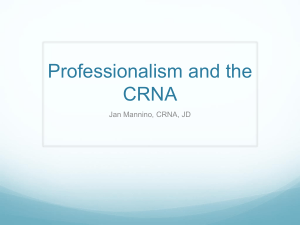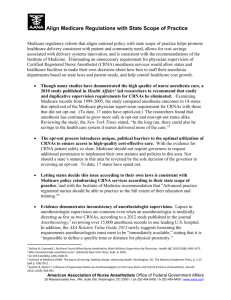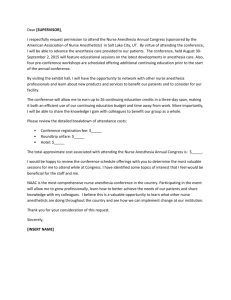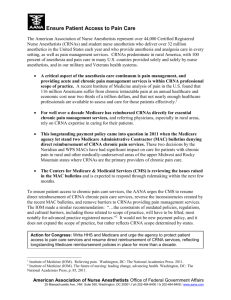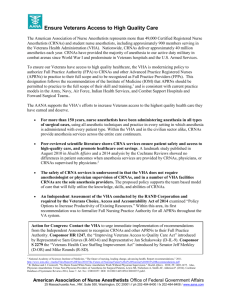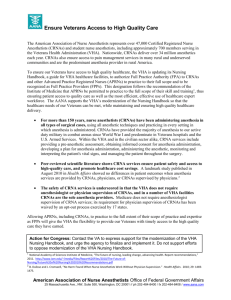Slideshow Script - Purdue University Calumet
advertisement
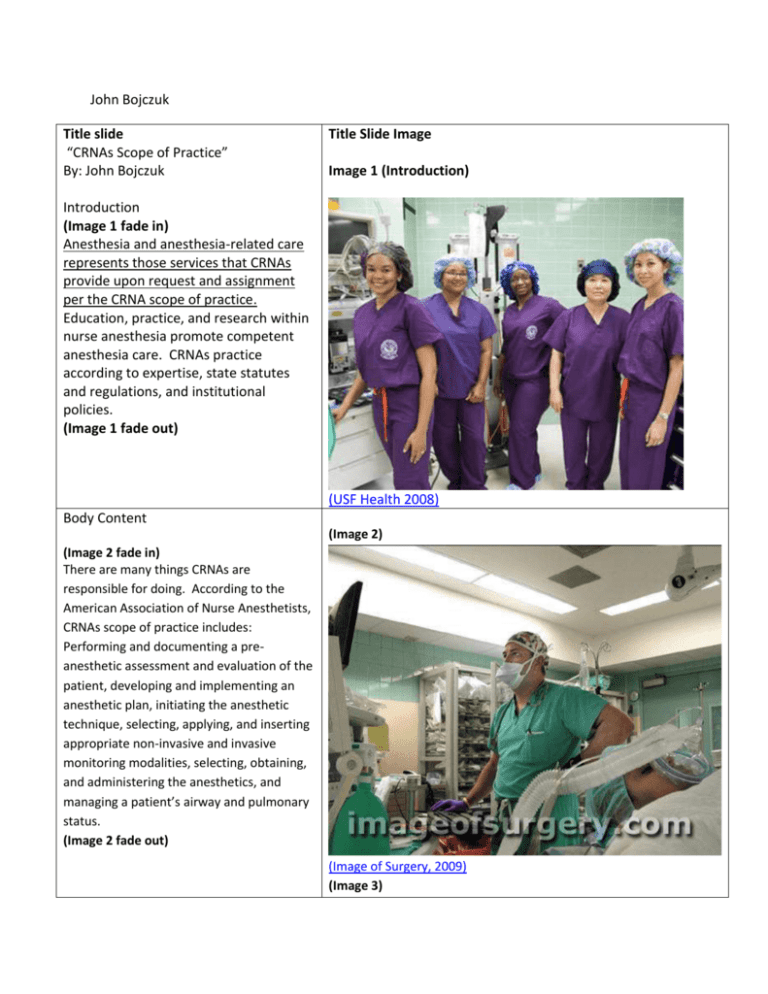
John Bojczuk Title slide “CRNAs Scope of Practice” By: John Bojczuk Title Slide Image Image 1 (Introduction) Introduction (Image 1 fade in) Anesthesia and anesthesia-related care represents those services that CRNAs provide upon request and assignment per the CRNA scope of practice. Education, practice, and research within nurse anesthesia promote competent anesthesia care. CRNAs practice according to expertise, state statutes and regulations, and institutional policies. (Image 1 fade out) (USF Health 2008) Body Content (Image 2) (Image 2 fade in) There are many things CRNAs are responsible for doing. According to the American Association of Nurse Anesthetists, CRNAs scope of practice includes: Performing and documenting a preanesthetic assessment and evaluation of the patient, developing and implementing an anesthetic plan, initiating the anesthetic technique, selecting, applying, and inserting appropriate non-invasive and invasive monitoring modalities, selecting, obtaining, and administering the anesthetics, and managing a patient’s airway and pulmonary status. (Image 2 fade out) (Image of Surgery, 2009) (Image 3) (Image 3 fade in) CRNAs responsibilities also includes: discharging the patient from post-anesthesia care and providing post-anesthesia followup evaluation, implementing acute and chronic pain management modalities, responding to emergency situations by providing airway management, and administration of emergency fluids and drugs. (Image 3 fade out) (Image 4 fade in) CRNAs main scope of practice seems long and confusing but it can be broken (Image of Surgery, 2009) down simply. Pre-anesthetic assessment (Image 4) and evaluation includes requesting consultations and diagnostic studies. This includes selecting, obtaining, ordering, and administering preanesthetic medications and fluids. CRNAs must also obtain consent for the anesthesia needed for the surgery. Initiating anesthesia technique includes general, regional, local, and sedation. (Image 4 fade out) (Image of Surgery, 2009) (Image 5 fade in) (Image 5) CRNAs have many individual responsibilities which are just as important as their main scope of practice. The American Association of Nurse Anesthetist says, “The additional responsibilities include: Administration/management, quality assessment, educational teaching, research, committee appointments, interdepartmental liaison, and clinical/administrative oversight of other departments.” (Image 5 fade out) (Image 6) The individual responsibilities can also be broken down simply. Scheduling, material and supply management falls under administration/management. Data collection, reporting mechanism, trending, compliance, committee meetings, and reviews directly deal with quality assessment. CRNA research has to deal with the conduction and participation in departmental/hospitalwide research projects. Finally, respiratory therapy and pain clinics deal with the clinical/administrative oversight. (Image 6 fade out) (Dartmouth-Hitchcock Medical Center 2010) (Image 6) (Image of Surgery, 2009) (Image 7) There are other privileges that CRNAs receive. According to the AANA credentialing, core privileges, and core clinical privileging can be achieved by a qualified CRNA. Credentialing is the recognition of professional and technical competence to verify information and evaluate an applicant requesting privileges. (Image 7 fade out) (Image 8 fade in) Core privileges are the scope of procedures and activities within a specialty that CRNAs have the experience, education, and competence to perform. This process provides an objective for initial application and renewal of clinical privileges. “They are based on education, experience, legal qualifications, and an assessment of the individual,” says the AANA. (Image 8 fade out) (image 7) (Franciscan Skemp Healthcare 2005) (Image 8) (Duke University School of Nursing 2009) (Image 9) (Image 9 fade in) The strive for excellence is trying to be achieved by setting such high standards for CRNAs. They are active in many other departments outside of anesthesia. (Image 9 fade out) (Gannett Education 2010) Conclusion (Image 10 fade in) (Image10) The scope of practice for CRNAs is extremely dynamic which requires them to be very well rounded anesthesia providers. Requirements will continue to grow making the title of CRNA quite an accomplishment if ever achieved. (Image 10 fade out) (UCLA Department of Anesthesiology 2010) For More Information Please Visit: http://www.aana.com/ Thank You Sources CRNA Scope of Practice.(2010). Retreived from the American Association of Nurse Anesthetists website. Scope and Standards for Nurse Anesthesia Practice.(2007). Retrieved from the American Association of Nurse Anesthetists website: http://www.aana.com/uploadedFiles/Resources/Practice_Documents/scope_stds_nap07_2007.pdf Recommended Reading Principle and Practice of Nurse Anesthesia is a book about nurse anesthetists and their practice of anesthesia. Images Image of Surgery. (2009). “Anesthesia Team.” Photo. http://www.imageofsurgery.com/Anesthesia_Team.htm. Accessed November 7, 2010 USF Health. (2008). “USF Charter CRNA Students.” Photo. http://hscweb3.hsc.usf.edu/health/now/?p=3162 . Accessed November 7, 2010 UCLA Department of Anesthesiology. (2010). “Nurse Anesthesia Education at UCLA”. Photo. http://www.anes.ucla.edu/news.php?id=90. Accessed November 7, 2010 Dartmouth-Hitchcock Medical Center.(2010), “Consultation & Resources.” Photo. http://www.dhmc.org/webpage.cfm?site_id=2&org_id=941&gsec_id=49478&sec_id=49478&item_id=49507. Accessed November 7,2010 Franciscan Skemp Healthcare: School of Nurse Anesthesia.(2005). “Clinical Affiliations.” Photo. http://www.uwlax.edu/biology/graduate/crna.htm. Accessed November 7, 2010 Duke University School of Nursing. (2009). “Nurse Anesthesia (CRNA) Specialty”. Photo. http://nursing.duke.edu/modules/son_academic/index.php?id=103. Accessed November 7, 2010 Gannett Education. (2010). “Nurse Week.” Photo. http://nursing-ce-seminar-case-management-dallastx.eventbrite.com/. Accessed November 7, 2010
